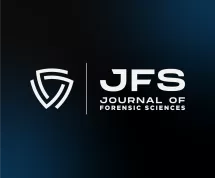Search
Explore content from JFS, ASB, the AAFS Newsfeed, and other content using the search bar or filters.
Evaluating novel and conventional cell‐separation techniques for sexual assault...
Biological evidence from sexual assaults frequently includes few male cells (i.e., spermatozoa) and numerous female cells (i.e., epithelial cells). In practice, their genetic analysis typically involves separating the victim's cells from the perpetrator's sperm using co...
Post‐mortem cardiomegaly descriptor: Call for consistent criteria
Although the post‐mortem descriptor of cardiomegaly is an important component of understanding a sudden death, there is no unified definition. A recent survey reported the usage of heart weight correction models of Molina or Kitzman, for example, or simple step cutoffs such as 35...
ASB Newsletter – July 11, 2025

Submit Your Abstract for Presentation at Last Word Society
Mycology and palynology: Preliminary results in a forensic experimental laboratory in...
Forensic mycology and palynology are emerging disciplines that offer valuable tools for solving crimes, particularly in cases of enforced disappearances and clandestine burials. This study, conducted in Bogotá, Colombia, aimed to explore the potential contributions of mycology an...
YFSF Seeking Speakers for 2026 Session
Call for Nominations: Criminalistics Section Awards
2026 ABFO Workshops
Abstract Submission Deadline Reminder
An alternate method for casting of three‐dimensional footwear imprints in snow and sand
Great Stuff™ is presented as an alternative material for the casting and preservation of three‐dimensional footwear impressions located in snow and sand. This method generates a detailed, 1:1 foam cast of questioned footwear imprints. Great Stuff™ is a readily available commercia...
Quality issue management and disclosure in forensic science: A survey of practice and...
Addressing calls for transparency regarding errors and limitations in forensic processes is an ongoing concern for the forensic science service provider community and the stakeholders it serves worldwide. Foundational to this goal is developing a consistent approach to the identi...
Method for estimating real‐scale 3D human body shape from an image based on 3D camera...
The combination of computer vision (CV) and computer graphics (CG) is being developed for use in many fields. Consequently, reverse projection photogrammetry, which identifies geometric properties of a subject based on accurate reproduction of the image content, is beginning to r...
Chemical profiling of developmental stages in three major flies via direct infusion mass...
Forensic entomology has become an essential tool for estimating the minimum postmortem interval (mPMI), especially in scenarios where traditional methods are limited. This study aimed to characterize and differentiate the chemical profiles of three major forensically relevant fly...
Decision trees for combining morphological traits and measurements of the skull for...
Forensic anthropologists commonly estimate osteological sex using separate metric and morphological analyses, without integrating both data types into a single statistical model. Combining data types into one classification model has the potential to increase sex classification a...
A preliminary study of the evaluation of breech face impressions produced by various...
During cartridge case comparisons, firearm examiners must distinguish between different markings found on the cartridge cases. These characteristics can be classified into class, subclass, or individual characteristics. There is potential for a false identification if firearm exa...
Psychotherapeutic treatment outcome of a female filicide patient
A case of double filicide of both her children admitted to a forensic psychiatric facility is described. According to the CARE guidelines (for CAse REports), a full description of the patient, clinical and diagnostic scenarios, the crime, psychotherapy treatment, and changes in p...
Examining the effects of 3D printed projectiles on firearm identification
In recent years, 3D printers have become more affordable for the average consumer to purchase, and new printers require less user input, making the process accessible to anyone who can download files online. Due to these factors, these printers are being used to manufacture firea...